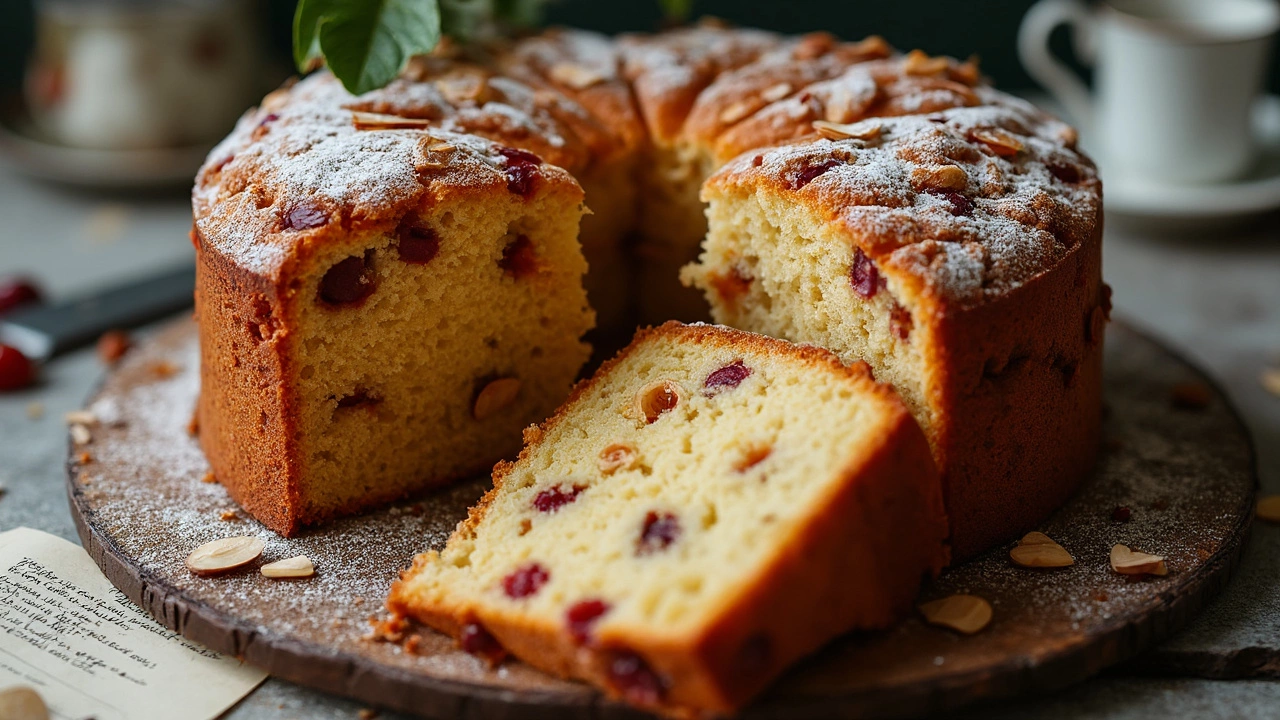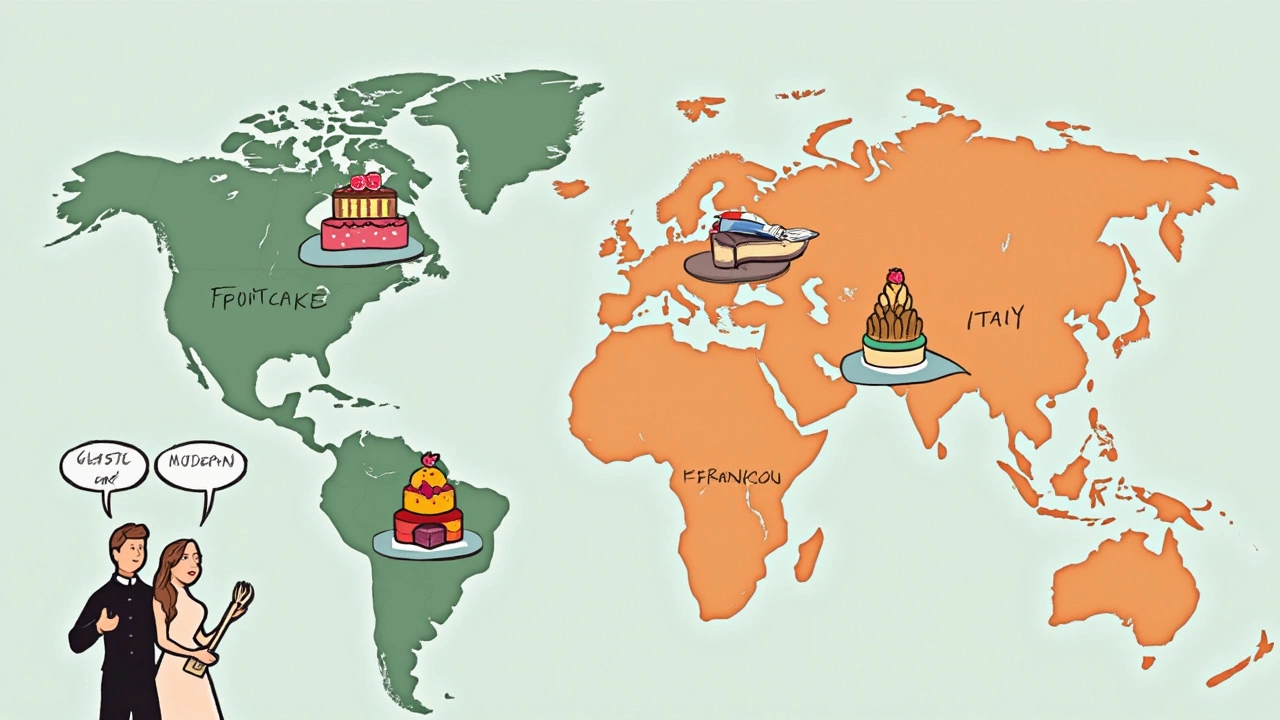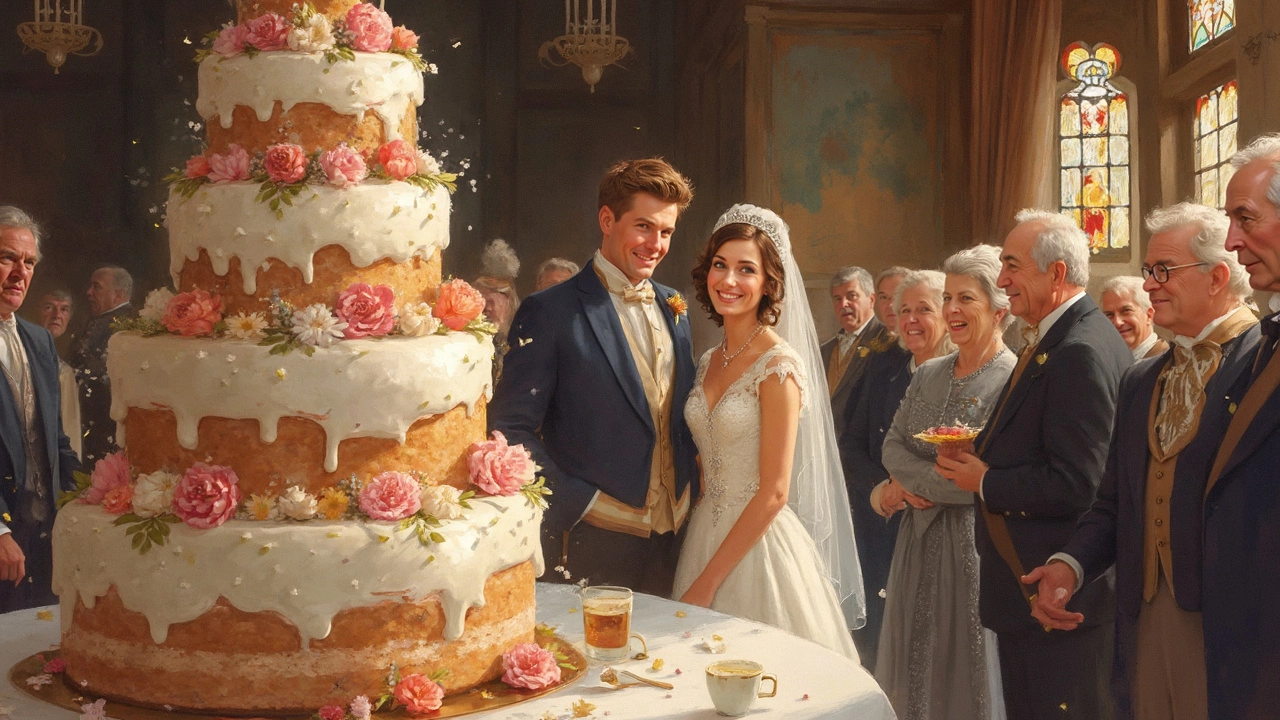Ever wonder why so many old-school wedding cakes taste like fruitcake? It’s not just some ancient joke—fruitcake actually had a pretty solid reason for stealing the spotlight at weddings. Packed with dried fruit, nuts, and a strong hit of booze, it survived long trips, weird weather, and the slow schedules of planning a huge wedding back in the day. People needed a cake that could last—sometimes for months—without going bad.
But tradition isn’t the whole story anymore. While fruitcake is the OG flavor, modern couples often swap it out for something that actually excites their taste buds. Still, you might spot fruitcake at royal weddings or in families that stick to age-old recipes. If you’re thinking about what’s ‘right’ for your big day, knowing a bit about why fruitcake topped those old dessert tables can help you decide if classic is your style too.
- Why Fruitcake Became the Traditional Wedding Cake
- How Traditions Vary Around the World
- Modern Takes on Classic Flavors
- Popular Alternatives to Classic Wedding Cake Flavor
- Tips for Choosing Your Own Classic Wedding Cake
Why Fruitcake Became the Traditional Wedding Cake
Back in the day, a wedding cake wasn’t all buttercream and sponge—fruitcake was the big deal. It sounds random until you realize why. Fruitcake lasts way longer than most cakes, thanks to all those dried fruits, nuts, and a good soaking of booze, usually brandy or rum. People wanted a cake you could bake ahead and keep fresh, especially with wedding planning dragged out for months or even a year. No one wanted a spoiled cake on the big day.
The tradition really took off in 18th and 19th century Britain. White icing became a status symbol, since refined sugar was expensive and hard to get. But underneath, the cake was always a rich, dense fruitcake. The Victorians even saved the top tier of their wedding cake flavor—yes, the fruitcake—for christenings down the line. Talk about getting your money’s worth.
People also believed the heavy, loaded cake showed off the family’s wealth. Nuts, spices, and alcohol weren’t cheap, so stacking them in a huge cake was a sign you could afford the best for your big day.
| Key Feature | Why It Mattered |
|---|---|
| Long Shelf Life | Survived months between baking and eating |
| Alcohol Content | Preserved the cake, boosted flavor |
| Expensive Ingredients | Sign of status and wealth |
| White Icing | Showed off sugar wealth in Victorian England |
| Easy Storage | Ideal when refrigeration didn't exist |
If you’re deep into family tradition or love the idea of a cake that packs a punch (and maybe a little booze), fruitcake still has its spot. And hey, in some places like the UK and Australia, classic fruitcake is still the go-to for royal weddings and folks who want that taste of history.
How Traditions Vary Around the World
Depending on where you look, the idea of a “traditional” wedding cake changes a lot. In the UK and Australia, fruitcake is still the star at many classic weddings. It’s often soaked in alcohol (like rum or brandy) to keep it fresh, then covered with thick marzipan and white royal icing. You’ll find a similar approach at royal weddings—even Queen Elizabeth II’s wedding cake in 1947 was a whopping nine feet tall fruitcake. No joke—they saved slices to eat on future anniversaries.
Now hop over to the United States, and things taste way different. White or vanilla sponge cakes are the most common wedding cake flavor for that traditional American vibe. These are often filled with buttercream, fruit preserves, or even chocolate. This preference kicked off in the late 1800s, as refined sugar became cheaper, leading to that prized “white as the bride” look for cakes.
In Italy, traditional cakes are a whole other ballgame. “Millefoglie” (lots of layers of thin pastry and cream) or “Torta della Nonna” (a custard-filled tart) are common for weddings, especially in northern regions. The French go big on “croquembouche,” a crazy-tall tower of cream puffs glued together with caramel, while Scandinavians might serve a kransekake—rings of chewy almond cake, stacked high and decorated with icing.
Here’s a quick look at traditional wedding cake choices in different places:
| Country | Traditional Cake | Main Flavors |
|---|---|---|
| UK/Australia | Fruitcake | Dried fruit, brandy or rum |
| USA | White cake | Vanilla, buttercream |
| France | Croquembouche | Choux pastry, caramel |
| Italy | Millefoglie | Puff pastry, cream, berries |
| Norway/Denmark | Kransekake | Almond, marzipan |
| Jamaica | Black cake | Fruit, rum, burnt sugar |
So, if you want to borrow a tradition or start your own, don’t feel boxed in by one country’s “right way.” There are many ways to honor your heritage (or just your favorite flavor) on your big day.

Modern Takes on Classic Flavors
If fruitcake doesn’t exactly get your mouth watering, you’re not alone. Lots of couples ask their wedding cake flavor expert for something with a classic vibe but with a modern twist. So, what does that look like?
Bakers now sneak classic flavors into updated recipes. Instead of the dense, boozy fruitcake from your grandma's wedding, you might see a light vanilla cake loaded with a hint of brandy and studded with berries. They’ll use smoother jams, seasonal fruits, or even candied citrus instead of dried fruits and nuts that can feel a bit heavy now.
Another trend is adding a thin layer of marzipan or fondant around something unexpected—think carrot cake with orange zest, or a fluffy almond sponge. These flavors still nod to old-school styles while being way easier on your taste buds.
Plenty of bakers go for British-style inspiration but keep the flavors fresh. Think lemon-elderflower (like Prince Harry and Meghan Markle picked), zesty orange, or cakes soaked in champagne. Even chocolate—never found in traditional royal cakes—makes a frequent appearance now, because, well, everyone loves chocolate.
| Flavor Modernization | Old-School Version | What Couples Order Now |
|---|---|---|
| Fruitcake | Dried fruits, booze, nuts | Vanilla, light spices, real fruit layers |
| Almond cakes | Dense marzipan-laced sponge | Almond sponge, whipped buttercream, fresh fruit |
| Citrus flavors | Candied orange and lemon | Lemon-elderflower, orange zest carrot cake |
| Spice cakes | Heavily spiced, thick icing | Light spice, cream cheese, thin fondant |
If you want a classic flavor profile but worry about Grandma giving you side-eye for ditching tradition, ask your baker to blend old and new. They might add a light boozy simple syrup to a vanilla or almond sponge, or decorate a modern cake with traditional touches like royal icing flowers or lace piping. Basically, you can get that sense of tradition…but serve something people actually want seconds of.
Popular Alternatives to Classic Wedding Cake Flavor
Fruitcake isn’t the only game in town anymore—far from it. These days, most wedding cake makers say couples want flavors that feel familiar, fun, or even a little bold. Vanilla and chocolate take the top spots, probably because pretty much everyone likes at least one of them. You’ll see plenty of cakes with vanilla bean sponge and real chocolate ganache instead of dried fruit and liquor.
Red velvet is another big hit, especially in North America. It’s not just about that bold look; people are drawn to the slight tang and creamy texture from its signature cream cheese frosting. Want something lighter? Lemon cake with fresh lemon curd or raspberry filling is popular for spring and summer weddings—it tastes fresh, and it won’t weigh people down after a meal. Carrot cake makes a surprising but cozy entry too, especially for casual or rustic weddings.
Cultural twists show up all over. In Italy, layered sponge cakes called millefoglie are filled with pastry cream and fruit. In Sweden, prinsesstårta blankets the cake in green marzipan. So if you want to break the mold, you’ve got lots of inspiration.
- Vanilla (especially with buttercream or berries)
- Chocolate (from dark and fudgy to milk-chocolate mousse)
- Red velvet (with cream cheese frosting)
- Lemon or citrus (with light curd or fruit fillings)
- Carrot cake (moist, with cream cheese icing)
The most important thing for a wedding cake flavor? It’s something both you and your guests will actually want to eat. Don’t feel boxed in by tradition; even the classics got their start because someone decided to try something different. Ask to taste a few options—most pros are happy to set up a tasting so you know exactly what you’re getting.

Tips for Choosing Your Own Classic Wedding Cake
Picking the perfect wedding cake flavor isn’t just about what’s trendy—it’s about finding something that fits your taste, your guests, and the feel of your wedding. Want a classic vibe, but not sure where to start? Here’s what actually works in the real world.
- Talk to your baker early. Most wedding cake makers can walk you through the old-school flavors and even let you try samples before you commit. Fruitcake is traditional, but flavors like vanilla, lemon, and almond have been top choices for decades in the UK and the U.S.
- Consider your guest list. Nearly 70% of couples pick flavors based on what pleases most guests, not just what’s traditional. If you’ve got a crowd that loves chocolate, there’s no rule that says you can’t make it classic by using a formal design or traditional frosting, like fondant or royal icing.
- Season matters. In summer, lighter flavors like lemon or coconut go over better, while winter weddings are perfect for rich fruitcakes or spice cakes.
- Mix and match. You don’t have to do just one flavor. A lot of couples ask for multiple tiers, each with a different flavor. That way, you keep old-school folks happy with a classic, but add something fun for yourself as well.
- Check if tradition influences your family or culture. If your family expects a certain type of cake—like the UK’s fruitcake with marzipan, or a tres leches cake in some Latin communities—it’s worth having at least a nod to that on the dessert table.
- Ask about allergens and dietary needs. Today, over 30% of weddings have at least one allergen-free or vegan tier. Make sure your classic pick can be adapted if needed.
Here’s a quick snapshot of what couples choose when picking their wedding cake flavors:
| Flavor | % of Couples Choosing |
|---|---|
| Vanilla | 27% |
| Chocolate | 23% |
| Lemon | 14% |
| Fruitcake (Traditional) | 9% |
| Other (Red Velvet, Carrot, etc.) | 27% |
If you want your "wedding cake flavor" to actually get eaten (and raved about), don’t be afraid to add some of your own personality into a time-tested recipe. Your baker can help make it work—classic flavor, modern twist, or both. The most important thing? You should actually love the taste when you go in for that first bite as a married couple.

